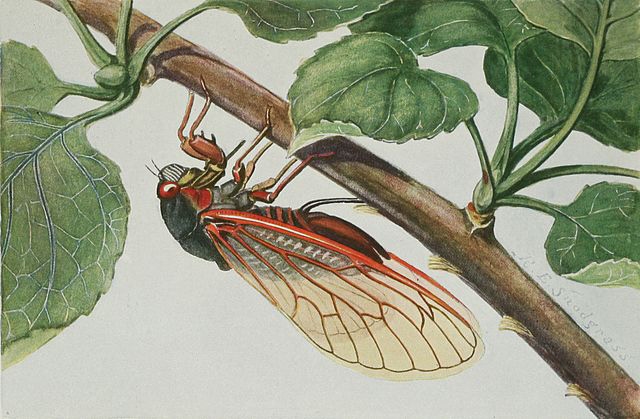by contributing editor, Ann McCulloh
The Locusts are coming! The Locusts are coming! Scary-looking, strange-sounding insects will soon be descending on Northeast Ohio in large numbers any day now. LATE-BREAKING NEWS – a few were spotted in Hudson on May 23 rd ! But unlike the Biblical plagues of locusts, and the hordes which devastated settlers’ crops on the Great Plains, this invasion is expected to have minimal impact on our gardens. Small fruit trees and newly planted trees and shrubs are somewhat vulnerable.
 Public Domain, https://commons.wikimedia.org/w/index.php?curid=695129)
Public Domain, https://commons.wikimedia.org/w/index.php?curid=695129)
The short version: a brood of periodical cicadas is just about to emerge from their 17-year dormancy/pupation underground. These are large (1-2” long) shiny black insects with bright orange wing veins and big red eyes – spooky-looking! The adults crawl out of holes in the ground in the morning, crawl up the nearest tree or shrub to dry out and harden their wings and bodies, then fly off to begin mating rituals which include a deafening chorus of keening from the treetops.
They emerge in LARGE numbers in late May when soil temperatures 8” below ground reach 64 degrees Fahrenheit. The adults fly, sing and mate (but don’t eat plants) until around the end of June. They can literally carpet the ground in places where they are prevalent, and the males’ song is incredibly loud, especially during midday. Outdoor weddings and graduation ceremonies may be memorably disrupted by these unearthly looking and sounding visitors.
Protecting your plants: The adults feed minimally, sucking a small amount of sap from twigs. Damage to plants is caused when the females scratch slits into smaller twigs on trees and shrubs, in order to lay their eggs. According to an article on the Morton Arboretum website https://www.mortonarb.org/trees-plants/tree-and- plant-advice/help- pests/periodical-cicadas , the trees most frequently affected are oak, hickory, apple, peach and pear. Young trees, especially fruit and nut trees, can benefit from protection during the June egg-laying period. Wrap fine-mesh netting over the branches, securing it tightly to the trunk to prevent the cicadas from crawling under it. Some insects may be discouraged by wrapping the trunk smoothly with a band of aluminum foil, but the majority will just fly to the branches instead.
There’s plenty of information about the fascinating 17-year cicada in a booklet produced by the Ohio Biological Survey. In Ohio’s Backyards: Periodical Cicadas (Gene Kritsky, 1999) includes detailed biology, historical accounts, superstitions, maps of various emergence years all over Ohio, and a recipe for Cicada Pie from a 1902 issue of the Cincinnati Enquirer! I’m putting my fellow foragers on notice! If I can collect enough recently-emerged cicadas (they need to be collected early in the morning before their shells have fully hardened) I plan to try pan-roasting some. Recipe-share, anyone?
We’ll all be waiting to hear the results of your roast. I think I’ll just stick with tamer fare like rose petal jam!